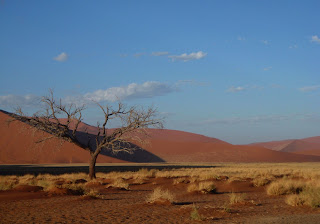As you drive into Entabeni game reserve, the huge rock that towers above the upper plains comes into view. Though I've been there three times this season, but it's still a sight that fills me with joy... maybe it's the hibernating geologist in me that stirs at the sight?
Usually there is also plenty of antelopes and other game grazing in the area, really perfecting the picture.
The altitude of the upper section of the reserve is a few hundred metres higher than the lower and therefore also a bit chillier, with misty mornings... almost romantically so some days.
Travelling down the 2 km long Yellowwood road the first time is an exhilarating experience and I always get the urge to throw myself off the highest cliff and soar like an eagle down into the valley below. However, since my flying abilities are more like those of a penguin, it will have to wait..? Not all the guests were impressed with the road and actually complained that the bush is too uncomfortable and bumpy!
With this view though, comfort is not the priority I would say.
Descending out of the mist into the more varied vegetation of the lower section, the scenery changes dramatically. Water lily filled dams truly make the beautiful background of the escarpment justice.
Descending out of the mist into the more varied vegetation of the lower section, the scenery changes dramatically. Water lily filled dams truly make the beautiful background of the escarpment justice.
As you go up to the plains again, you can't always see more than a couple of metres of the road in front of you, which is rather disconcerting at night, as anything may show up in the dark. One night, as we were making our way back up along the steepest part of Yellowwood, a wildebeest surprised us on the narrow road, but maybe not as much as we surprised him.
I thought he would have a heart attack as he froze for a second in the bright headlights of the game viewer, before rushing past us down hill with gravel flying around him as he went... making MY heart skip a beat.
On a late evening ascent we came across a fairly sluggish puffadder at the top. Guests often ask about snakes and whether they are common, but this was actually my first sighting at Entabeni, on the last drive of the season!
I thought he would have a heart attack as he froze for a second in the bright headlights of the game viewer, before rushing past us down hill with gravel flying around him as he went... making MY heart skip a beat.
On a late evening ascent we came across a fairly sluggish puffadder at the top. Guests often ask about snakes and whether they are common, but this was actually my first sighting at Entabeni, on the last drive of the season!
In the cool night, the slow moving serpent was of course the centre of attention while flashes cut through the night, before making our way to a braai under the starry African night sky.
/A
























